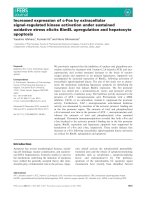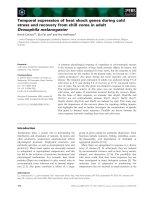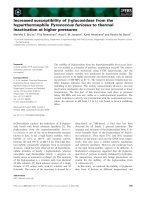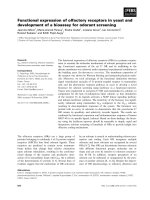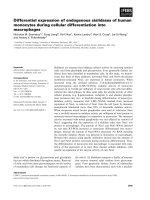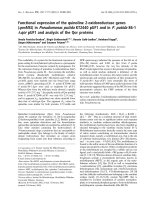Báo cáo khoa học: "Increased expression of osteopontin in the spinal cords of Lewis rats with experimental autoimmune neuritis" doc
Bạn đang xem bản rút gọn của tài liệu. Xem và tải ngay bản đầy đủ của tài liệu tại đây (2.3 MB, 5 trang )
-2851$/ 2)
9H W H U L Q D U \
6FLHQFH
J. Vet. Sci.
(2004),
/
5
(4), 289–293
Increased expression of osteopontin in the spinal cords of Lewis rats with
experimental autoimmune neuritis
Changjong Moon, Taekyun Shin*
Department of Veterinary Medicine, Cheju National University, Jeju 690-756, Korea
To investigate the pattern of expression of osteopontin
(OPN) in tissues of the central nervous system (CNS)
responding to peripheral immunological stimulation, the
expression of OPN was studied in the spinal cord of rats
with experimental autoimmune neuritis (EAN). In this
model system, the sciatic nerves and spinal nerve roots are
the target organs of EAN and the spinal cord is a remote
organ that may be indirectly affected. OPN was
constitutively expressed in some astrocytes adjacent to the
pia mater and neurons in normal rats. In rats with EAN,
OPN was increased in the same cells and in some
inflammatory cells, including macrophages in the
subarachnoid space. Expression of CD44, a receptor of
OPN, was weak in normal spinal cord tissue and
increased in the entire spinal cord parenchyma in rats
with EAN, as well as in inflammatory cells. These findings
suggest that inflammatory cells as well as reactive
astrocytes are major sources of OPN and CD44 in the
spinal cord of rats with EAN. Further study is needed to
elucidate the functional role of OPN in the spinal cord
affected by EAN.
Key words:
Experimental autoimmune neuritis, osteopontin,
CD44, spinal cord
Introduction
Experimental autoimmune neuritis (EAN) is a T-cell-
mediated autoimmune disease of the peripheral nervous
system that is used as a model of human demyelinating
diseases [17]. The clinical course of EAN is characterized
by weight loss, ascending progressive paralysis, and
spontaneous recovery. It has been proposed that
inflammatory mediators produced in the affected spinal
nerve roots and sciatic nerves are involved in the
pathogenesis of EAN [22]. Although the major lesions of
EAN are seen in the spinal nerve roots and sciatic nerves of
rats, the observed activation of microglia in the spinal cord
indicates that the spinal cord is also affected [7,11].
Osteopontin (OPN) is an integrin- and calcium-binding
phosphoprotein that is produced by mineralized tissue cells,
many epithelial cells, and activated immune system cells [4].
OPN is known to be a pro-inflammatory mediator; its
expression is increased in several pathological conditions,
including spinal cord injury [9], Theiler’s murine
encephalomyelitis virus-induced demyelination [15], and
experimental autoimmune encephalomyelitis [13]. In the
spinal root avulsion model, two contradictory roles of OPN
have been proposed [5]: that OPN functions as a pro-
inflammatory mediator in the central nervous system (CNS),
as has been shown in an autoimmune disease model [3], and
that OPN is an intrinsic inhibitor of inflammation through
the suppression of inducible nitric oxide synthase (iNOS), as
has been shown in rheumatoid arthritis [1].
In the peripheral autoimmune disease model, some
evidence indicates activation of cells in the spinal cord, the
remote organ [11], which is distant from the target organs,
the sciatic nerves. However, little is known about the
expression of OPN protein in the spinal cord. In order to
affect function in nearby cells, OPN requires an appropriate
receptor such as CD44, a known OPN receptor [19,20]. The
interactions of OPN with its receptors regulate macrophage
migration and activation [19,20].
The aim of the present study was to elucidate the patterns
of expression of OPN and its receptor, CD44, in the spinal
cords of rats with EAN.
Materials and Methods
Induction of EAN
Lewis rats were obtained from Harlan (Sprague Dawley,
USA) and bred in our animal facility. Female rats, aged 7-12
weeks and weighing 160-200 g, were used. Each rat was
injected in both hind feet with 200
µ
l of an emulsion
containing equal parts of horse sciatic nerve in phosphate
buffer (mg/ml) and complete Freund’s adjuvant (CFA;
Mycobacterium tuberculosis H37Ra, 5 mg/ml; Difco, USA).
*Corresponding author
Tel: +82-64-754-3363; Fax: +82-64-756-3354
E-mail:
290 Changjong Moon, Taekyun Shin
Each rat was treated with 50 ng of pertussis toxin (Sigma,
USA) on days 0 and 2 after immunization. Immunized rats
were observed daily for clinical signs of EAN. The
progression of EAN was categorized into seven clinical
stages, as follows. Grade (G) 0, no clinical signs; G1, floppy
tail; G2, mild paraparesis; G3, severe paraparesis; G4,
tetraparesis; G5, moribund condition or death; R0, recovery.
Control rats were immunized with CFA only. Five rats were
sacrificed under deep anesthesia at selected stages of EAN.
Experiments were carried out in accordance with the
National Institutes of Health guidelines for the care and use
of laboratory animals.
Tissue sampling
To study OPN expression in animals with EAN, spinal
cord tissue and sciatic nerves were sampled during
paraparesis (day 14-18 post-immunization) and during
recovery from paraparesis (after day 21 post-immunization).
Spinal cords from CFA-immunized control rats were
obtained at day 17 post-immunization. Samples of spinal
cords and sciatic nerves were embedded in paraffin after
fixation in 4% paraformaldehyde in phosphate-buffered
saline (PBS) at pH 7.4.
Immunohistochemistry
Paraffin tissue sections (5 µm) were deparaffinized and
hydrated. The sections were treated with 0.3% hydrogen
peroxide in distilled water for 20 min to block endogenous
peroxidase activity. After three washes in PBS, the sections
were exposed to 10% normal goat serum and then incubated
for 1 h at room temperature with polyclonal rabbit antisera
to rat OPN (1 : 800 dilution; Santa Cruz, USA) or CD44
(1 : 1600 dilution; Pharmingen, USA). To identify astrocytes
and macrophages, rabbit anti-glial fibrillary acidic protein
(GFAP) (1 : 800 dilution; Sigma, USA) and ED1 (1 : 1600
dilution; Serotec, UK) were used, respectively. After three
washes, the sections were incubated with the appropriate
biotinylated second antibody, followed by formation of the
avidin-biotin peroxidase complexes using the Elite kit
(Vector, USA). The peroxidase reaction was developed with
a diaminobenzidine substrate kit (Vector, USA). Before
mounting, the sections were counterstained with hematoxylin.
Results
Histological findings in the rat spinal cord and sciatic
nerve in EAN
Lewis rats immunized with neuritogenic antigens
developed paraparesis 14 to 17 days post-immunization, and
gradually recovered from paraparesis after 21 days post-
immunization.
In our previous report, histologic examination demonstrated
some inflammatory cells in the sciatic nerves of Lewis rats
immunized with neuritogenic antigens during the paraparesis
stage of EAN (days 14-17 post-immunization), as well as
abundant inflammatory cells in the spinal nerve roots in the
same animals [14]. To investigate remote activation of the
CNS in peripheral nervous system disease, we focused on
the spinal cord in the present study.
During the paraparesis stage of EAN, cellular infiltrates
were detected in the subarachnoid space of the rat spinal
cord (days 14-17 post-immunization; Fig. 1B, arrowheads),
while very few cells were found in the subarachnoid space
of normal rats or control rats immunized with CFA (Fig.
1A). These findings suggest that cellular infiltration of the
CNS occurs even in peripheral autoimmune disease, such as
the EAN model.
Glial cell activation and appearance of macrophages in
the rat spinal cord in EAN
To examine the activation of spinal cord cells in EAN, we
performed immunostaining for ED1 and GFAP to identify
activated microglia/macrophages and astrocytes. In normal
or CFA-immunized rats, few ED1-positive macrophages in
the spinal cords were detected (Fig. 2A) and GFAP-positive
astrocytes had thin processes (Fig. 2B, arrows). In rats with
EAN, ED1-positive macrophages were present in the
subarachnoid space and in the parenchyma (Fig. 2C,
arrows), and some astrocytes had thick processes near the
pia mater (Fig. 2D, arrows).
Glial cells, subarachnoid macrophages and neurons in
the spinal cord express OPN and CD44 in EAN
Immunohistochemistry showed expression of OPN in
some cells in the spinal cord parenchyma and in the
subarachnoid space in rats with EAN. In the parenchyma, it
was evident that OPN was expressed in the motor neurons
(Fig. 3A), which express OPN weakly in normal adult rats
In addition, OPN was expressed in some astrocytes (Fig. 3B,
arrowheads), mainly located in the subpial lesions, and in
macrophages in the subarachnoid space (Fig. 3B, arrows),
F
ig. 1.
Histology of spinal cords of normal (A) and EAN affect
ed
(
B) rats. A. There were no inflammatory cells in the spinal co
rd
p
arenchyma or subarachnoid space. B. Infiltrating inflammato
ry
c
ells were present in the subarachnoid space (arrowheads), b
ut
v
ery few were found in the spinal cord parenchyma. H
-E
s
taining. Scale bars represent 50
µ
m.
Osteopontin in rat spinal cord with EAN 291
which were identified by positive ED1 staining in the
adjacent section (Fig. 3C, arrows).
In the spinal cords of control rats, low-intensity
immunostaining for CD44 was diffusely detected in some
glial cells (Fig. 4A), while in rats with EAN CD44
immunoreactivity was shown in ED1-positive inflammatory
cells in the subarachnoid space (Fig. 4, B and C), and was
increased in GFAP-positive astrocytes (Fig. 4, D and E).
The results of the immunohistochemical analysis of the
distribution of OPN and CD44 are summarized in Table 1.
Discussion
This is the first study to examine the expression of OPN
and its receptor, CD44, in the spinal cord of rats with EAN.
Many studies of EAN have investigated the pathologic
changes in the target organ, the sciatic nerves, in the rat
Fig. 2.
Immunostaining for ED1 and GFAP in the normal (A and
B) and EAN-affected spinal cords (C and D). In normal rat spinal
cords, there were few ED1-positive macrophages, and GFAP-
positive cells (astrocytes) had thin processes in the white matter
(B). In EAN animals, some ED1-positive macrophages were
found in the subarachnoid space (C, arrows), and astrocytes had
thicker processes near the pia mater, as compared to controls (D
and B, respectively, arrows). Counterstained with hematoxylin.
Scale bars represent 50
µ
m.
Fig. 3.
Immunostaining for OPN in the spinal cords of normal
and EAN-affected rats. OPN (A, arrowheads) was quite weakly
expressed in neurons in normal spinal cords. In EAN-affected
animals, OPN (B, arrows) was localized either in ED1-positive
cells (C, arrows), or in some astrocytes (B, arrowheads).
Counterstained with hematoxylin. Scale bars represent 50
µ
m.
F
ig. 4. Immunostaining for CD44 in the spinal cord of norm
al
a
nd EAN-affected rats. CD44 was expressed weakly in som
e
g
lial cells in normal spinal cords (A). In EAN-affected anima
ls,
C
D44 (B, D, arrows) was localized either in ED1-positive cells
in
t
he subarachnoid space (C, arrow), or in GFAP-positi
ve
a
strocytes (E, arrows). Counterstained with hematoxylin. Sca
le
b
ars represent 50
µ
m.
292 Changjong Moon, Taekyun Shin
model [21,22]. EAN lesions in the sciatic nerve and the
spinal nerve roots are characterized by the infiltration of T
cells and macrophages, in addition to activation and
apoptosis of Schwann cells [21]. In a few cases of EAN,
cellular infiltrates have also been confirmed in the cauda
equina of the spinal cord [6], suggesting that autoimmune T
cells and bystander macrophages may infiltrate the
subarachnoid space non-specifically. Since these inflammatory
cells secrete a variety of chemokines in the cauda equina in
EAN [6,12], it is possible that spinal cord cells would be
vulnerable to their effects, depending on the characteristics
(pro- or anti-inflammatory) of the chemokines and the
amount secreted. In previous studies, it was evident that
spinal cords of rats with EAN also responded immunologically,
through the activation of microglia or astrocytes [7,11].
In the present study, we examined the expression of OPN
in the spinal cords of rats with EAN. We found that some
inflammatory cells infiltrated the spinal nerve roots, and
subarachnoid space, but only rarely infiltrated the spinal
cord parenchyma. OPN was expressed in some macrophages
in the subarachnoid space and in some astrocytes in the
parenchyma, mainly near the pia mater. These findings
suggest that inflammatory cells may stimulate the
expression of OPN in macrophages and astrocytes, in either
an autocrine or paracrine manner.
Since the expression of OPN paralleled the clinical course
of EAN in the present study, as well as that of experimental
autoimmune encephalomyelitis (EAE) in our previous study
[13], it is not difficult to postulate a role for OPN as a pro-
inflammatory mediator. Also, OPN has been shown to
suppress iNOS in cultured macrophages stimulated by
cytokines [8,18]; iNOS is also an important molecule in the
pathogenesis of EAN [14]. Although there is a consensus
that OPN is a pro-inflammatory mediator in EAE models in
OPN knockout mice [10], a contradictory role for OPN has
also been suggested [5] because it suppresses the generation
of nitric oxide [1]. We postulate, then, that OPN in the
macrophages of the subarachnoid space may temporarily
function as a pro-inflammatory mediator at the early
activation stage, and thereafter function in an anti-
inflammatory role, through the suppression of nitric oxide
generation in an autocrine or a paracrine manner.
OPN requires the presence of its receptor on the cell
surface for internalization into brain cells. CD44 has been
shown to be a receptor of OPN [2]. It was weakly expressed
in the white matter of the normal spinal cord in our previous
study [13] and in the present study. In rats having spinal cord
infiltrates of inflammatory cells during EAN, intense CD44
immunostaining was detected in astrocytes, suggesting that
OPN could bind to astrocytes in the subpial lesions.
Moreover, the majority of inflammatory cells express CD44,
implying that these cells also bind OPN. In addition, CD44
expression in the astrocytes in EAN-affected spinal cords
may facilitate the migration of inflammatory cells, including
both Th1 and Th2 cells, into the spinal cord parenchyma if
needed. The population of inflammatory cells in the
subarachnoid space may include both Th1 and Th2 cells, as
has been well established in investigations of a variant
model of autoimmune CNS disease [16].
Taken all the findings into consideration, it is postulated
that OPN and its receptor CD44 increase in the spinal cord,
a remote lesion, from EAN target tissue including sciatic
Table 1.
CD44 and osteopontin immunoreactivity in the spinal cords of normal and CFA-immunized control rats, and rats with EAN
Antibody and cell type Normal CFA control (D17 PI)
a
EAN G2 (D17 PI)
Anti-CD44
b
Neurons -
c
Astrocytes Weak
d
Moderate Moderate
Macrophages
e
ND
f
ND
f
++
T cells
g
(ED1 negative) ND
f
ND
f
+++
Ependymal cells - - -
Anti-osteopontin
Neurons + + +
Astrocytes
h
++++
Macrophages
e
ND
f
ND
f
+
T cells
g
(ED1 negative) ND
f
ND
f
++
Ependymal cells - - -
a
Rat spinal cords were obtained at days 17 (CFA control), and 17 post-immunization (PI) (EAN, G.2).
b
Three different sections from three animals in each group were examined by two observers in a blinded fashion.
c
The presence of immunoreactive cells in the spinal cord was expressed as negative (-), <10 cells (+), 10-30 cells (++), and >30 cells (+++) per field
under 20X magnification.
d
The intensity of CD44 immunostaining in astrocytes was classified as weak, moderate, and intense by two observers in a blinded fashion.
e
Macrophages included activated microglia and/or ED1-positive cells.
f
ND (Not detected): there were no inflammatory cells in the spinal cords of normal rats.
g
In paraffin sections, we classified small round cells as T cells that were negative ED1.
Osteopontin in rat spinal cord with EAN 293
nerves and spinal roots. These two molecules may be
involved in cell migration into the spinal cord in the early
stages of EAN. Further study of the functional role of OPN
will be required to determine whether it acts as a pro- or
anti-inflammatory mediator, or both.
Acknowledgments
This study was supported by a grant from the Korean
Health 21 Research & Development Project, The Ministry
of Health & Welfare, Republic of Korea (02-PJ1-PG10-
21305-0003).
References
1. Attur MG, Dave MN, Stuchin S, Kowalski AJ, Steiner G,
Abramson SB, Denhardt DT, Amin AR. Osteopontin: an
intrinsic inhibitor of inflammation in cartilage. Arthritis
Rheum 2001, 44, 578-845.
2. Borland G, Ross JA, Guy K. Forms and functions of CD44.
Immunology 1998, 93, 139-148.
3. Chabas D, Baranzini SE, Mitchell D, Bernard CC,
Rittling SR, Denhardt DT, Sobel RA, Lock C, Karpuj M,
Pedotti R, Heller R, Oksenberg JR, Steinman L. The
influence of the proinflammatory cytokine, osteopontin, on
autoimmune demyelinating disease. Science 2001, 294,
1731-1735.
4. Denhardt DT, Guo X. Osteopontin: a protein with diverse
functions. FASEB J 1993, 7, 1475-1482.
5. Fu Y, Hashimoto M, Ino H, Murakami M, Yamazaki M,
Moriya H. Spinal root avulsion-induced upregulation of
osteopontin expression in the adult rat spinal cord. Acta
Neuropathol (Berl) 2004, 107, 8-16.
6. Fujioka T, Purev E, Rostami A. Chemokine mRNA
expression in the cauda equina of Lewis rats with
experimental allergic neuritis. J Neuroimmunol 1999, 97, 51-
59.
7. Gehrmann J, Gold R, Linington C, Lannes-Vieira J,
Wekerle H, Kreutzberg GW. Spinal cord microglia in
experimental allergic neuritis. Evidence for fast and remote
activation. Lab Invest 1992, 67, 100-113.
8. Guo H, Cai CQ, Schroeder RA, Kuo PC. Osteopontin is a
negative feedback regulator of nitric oxide synthesis in
murine macrophages. J Immunol 2001, 166, 1079-1086.
9. Hashimoto M, Koda M, Ino H, Murakami M, Yamazaki
M, Moriya H. Upregulation of osteopontin expression in rat
spinal cord microglia after traumatic injury. J Neurotrauma
2003, 20, 287-296.
10. Jansson M, Panoutsakopoulou V, Baker J, Klein L,
Cantor H. Attenuated experimental autoimmune
encephalomyelitis in eta-1/osteopontin-deficient mice. J
Immunol 2002, 168, 2096-2099.
11. Kiefer R, Gold R, Gehrmann J, Lindholm D, Wekerle H,
Kreutzberg GW. Transforming growth factor beta
expression in reactive spinal cord microglia and meningeal
inflammatory cells during experimental allergic neuritis. J
Neurosci Res 1993, 36, 391-398.
12. Kieseier BC, Krivacic K, Jung S, Pischel H, Toyka KV,
Ransohoff RM, Hartung HP. Sequential expression of
chemokines in experimental autoimmune neuritis. J
Neuroimmunol 2000, 110, 121-129.
13. Kim MD, Cho HJ, Shin T. Expression of osteopontin and its
ligand, CD44, in the spinal cords of Lewis rats with
experimental autoimmune encephalomyelitis. J Neuroimmunol
2004, 151, 78-84.
14. Lee Y, Shin T. Expression of constitutive endothelial and
inducible nitric oxide synthase in the sciatic nerve of Lewis
rats with experimental autoimmune neuritis. J Neuroimmunol
2002, 126, 78-85.
15. Shin T, Koh CS. Immunohistochemical detection of
osteopontin in the spinal cords of mice with Theiler's murine
encephalomyelitis virus-induced demyelinating disease.
Neurosci Lett 2004, 356, 72-74.
16. Shin T, Matsumoto Y. A quantitative analysis of CD45Rlow
CD4+ T cells in the subarachnoid space of Lewis rats with
autoimmune encephalomyelitis. Immunol Invest 2001, 30,
57-64.
17. Suzuki M, Kitamura K, Uyemura K, Ogawa Y, Ishihara
Y, Matsuyama H. Neuritogenic activity of peripheral nerve
myelin proteins in Lewis rats. Neurosci Lett 1980, 19, 353-
358.
18. Takahashi F, Takahashi K, Maeda K, Tominaga S,
Fukuchi Y. Osteopontin is induced by nitric oxide in RAW
264.7 cells. IUBMB Life 2000, 49, 217-221.
19. Weber GF, Ashkar S, Glimcher MJ, Cantor H. Receptor-
ligand interaction between CD44 and osteopontin (Eta-1).
Science 1996, 271, 509-512.
20. Weber GF, Zawaideh S, Hikita S, Kumar VA, Cantor H,
Ashkar S. Phosphorylation-dependent interaction of
osteopontin with its receptors regulates macrophage
migration and activation. J Leukoc Biol 2002, 72, 752-761.
21. Weishaupt A, Bruck W, Hartung T, Toyka KV, Gold R.
Schwann cell apoptosis in experimentally induced
autoimmune neuritis of the Lewis rat and the functional role
of tumor necrosis factor-alpha. Neurosci Lett 2001, 306, 77-
80.
22. Zhu J, Mix E, Link H. Cytokine production and the
pathogenesis of experimentally induced autoimmune neuritis
and Guillain-Barre syndrome. J Neuroimmunol 1998, 84, 40-
52.




